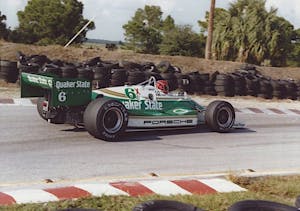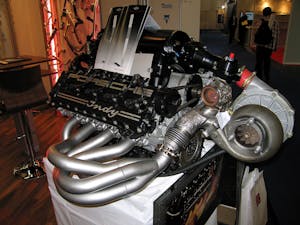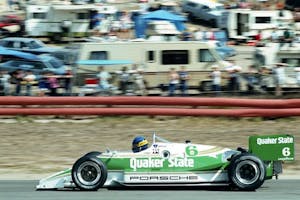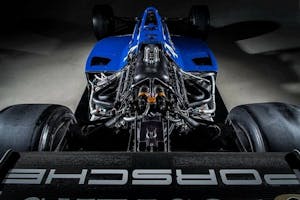Porsche’s failed IndyCar racing program proved even the best can’t go it alone
Few country music fans remember the debut of Chris Gaines, the alt-rock alter ego of world-conquering performer Garth Brooks. Fueled by a seemingly unending string of successes at the end of the 1990s, Brooks became convinced that he could just as easily woo music fans from outside the pick-and-grin community as he could his traditional base—and that he could do it by pretending to be someone else entirely.
It was not to be. Although Gaines’ sales were initially strong, they fell far short of what Brooks, who has moved over 170 million albums in his lifetime, was used to. Combined with the confusion over whether Gaines was Brooks, or Brooks was Gaines, the entire effort was far too inconsistent for fans to latch onto, and the concept eventually became fodder for late night comedians and dagger-bearing music critics alike. Brooks would quickly extinguish all plans to promote the Chris Gaines persona, including a motion picture, and the entire effort would disappear into the artist’s archives as his most off-the-wall stab at infiltrating the Billboard Hot 100.

What does any of the above have to do with Porsche’s attempt toward the end of the 1980s to expand its impressive racing success into the open wheel environment of the CART IndyCar series? Like Brooks, the strategists from Stuttgart were confident that their mastery of nearly every sports car series they had ever entered would translate into a similar dominance of America’s oldest-running championship. The German brain trust also opted to go it completely alone in developing its entire program, designing not just an engine suited for Indy’s high speeds, but also an all-new chassis, despite having close to zero experience with oval competition.
See where this is going? Strap in, and feel free to crank up the Chris Gaines.
CART before the horse
Porsche had made one prior effort to interface with Indy’s American fans, back in 1980 when it tested a planned turbocharged flat-six-engined open-wheel design at Ontario Motor Speedway. That effort was dashed by a quick rule change that reclassified the 935-sourced motor as a pure race power plant, reducing allowable boost and rendering it non-competitive. Startled by the politicized takedown executed by United States Auto Club, the automaker withdrew, refocusing on IMSA and Formula 1.
Things were different seven years later. Backed by CEO Peter Schutz and managed by give-time IMSA champion Al Holbert (who was wearing two hats as director of Porsche’s North American motorsports operations), the automaker was set to bring a brand-new, 2.65-liter turbocharged V-8 (designed by Hans Mezger, and good for 800 horsepower) matched with an in-house chassis, dubbed the 2708.

It’s unclear why Porsche elected to run the final two races of the 1987 CART calendar, given that the 2708-powered car had barely had time for any testing whatsoever. In fact, the development team had been unusually resistant to the idea of putting the body shape through its paces via a rolling road wind tunnel, despite repeated urging from luminary driver Mario Andretti, after having spent some time behind the wheel, to do so.

Porsche’s confidence in its product stemmed in part from how quickly the development for its original 1980 test car had been, even though that example rode on a third-party chassis. Unfortunately, this was the racing team’s first effort at producing a true open-wheel ground effect car, and the aero data logged nearly a decade beforehand no longer reflected the much faster reality in the current IndyCar starting grid. Convinced it had a winning hand right out of the box, Porsche rolled in to the paddock at Laguna Seca intent on shaking up the status quo.
Even with Al Unser behind the wheel, however, it was clear that Porsche was out of its depth. The car had trouble just keeping pace with Indy’s back-markers. Starting third from last, the 2708 proved to be heavier than most of its rivals while failing to offer the downforce required for Unser to truly take advantage of its prodigious horsepower. To make matters worse, Porsche tapped out seven laps into the race due to mechanical difficulties. Trouble continued as the team failed to even qualify for the next event in Miami.
It was a stunning reversal for a company accustomed to excellence wherever it chose to race. Porsche was forced to quickly reconcile with the reality that it had fallen short. It had been clear to everyone around the series, too, that Porsche was almost entirely unprepared for the rigors of Indy.
Back to square one
With an entire off-season to ponder its problems, Porsche ditched its bespoke chassis for an off-the-shelf March 88C chassis for the following 1988 season. Part of that decision had to do with a plan for March to work on a custom solution for Porsche which could be implemented the year after.
Each car remained based around the same 2.65-liter V-8. With talented driver Teo Fabi now in the cockpit, the 2708 would see as high as a 4th place finish at Nazareth in 1988 … but that was as high as the Germans climbed; another string of mid-pack finishes and mechanical failures resulted in a 10th-place finish in points at the end of the year.

A far more serious hit to the 2708 program was the death of Al Holbert in October of the same year, as the result of an aviation accident. Rudderless in the world of American motorsports, Porsche relied on former Penske manager Derek Walker to whip things into shape for the 1989 season.
Finally starting to gel
The arrival of the March 89P—a car that had been built with Porsche’s input—would herald the best year ever for the brand’s IndyCar program. It was a low bar to clear, but a single win at Mid-Ohio (buttressed by a trio of podium finishes and five additional top fives) propelled Teo Fabi to claim the fourth overall position in the driver’s standings as the season came to an end.

This was hardly the result expected overseas, especially given that the 2708 had yet to finish an Indy 500, this time dropping out after 23 laps. Still, there was a lot to like about the newly revamped V-8. When the engine wasn’t breaking down and forcing the team to retire, the car managed to hang with more established competitors (thanks in part to advanced engine management system developed by Porsche). Convinced it was on the verge of success, Porsche green-lit a two-car team for 1990, with John Andretti sliding into the second seat alongside a returning Fabi.
Outmaneuvered, outrun, out of gas
Porsche was not clear of trouble, however, once again running headlong into the political cabal governing Indy competition. When the March 90P arrived on the scene in 1990, it was instantly targeted by team owners scared witless that the advanced carbon-fiber design would run roughshod over their less-advanced entries.

Facing a revolt, CART declared the 90P “unsafe” due to how low the driver sat in the design. This judgement was laid bare by data that proved the March chassis was actually better at protecting the occupant than any other in the series. It was a move that would later be derided as shortsighted by a ruling body seemingly intent on chasing away a big-money newcomer.

Forced to pivot with almost zero time remaining before the start of the season, Porsche and March ended up rushing a heavier, less structurally stiff aluminum design to Indy, while running earlier races on the schedule using the previous year’s design. It was a recipe for disaster: another virtually untested Porsche chassis suffered numerous technical issues taking it out of contention, and the decision to stuff the turbo between the engine and the driver created a serious fire risk during refueling if the heat generated from the turbo should ignite methanol fumes. Hundreds of in-season adjustments were required to keep the 90P rolling, and Fabi finished 10 spots behind his previous year’s highlight (with Andretti taking 10th in the points race).
Lessons learned, lessons ignored
Unsurprisingly, Porsche pulled the plug on its Indy dream after the 1990 season. Facing mounting financial problems across the board, the company was unwilling to further finance what had turned out to be an expensive and embarrassing debacle. Although rumors of a return as an engine builder would percolate throughout 2019, to this day Porsche has never again set foot at the Brickyard, leaving Indianapolis with no better than an 18th place finish.

There are plenty of lessons to be drawn from Stuttgart’s approach to CART. Without a solid foundation in the series, it was a massive risk to invest in an in-house development program using data that no longer reflected the state of the art. Tapping an experienced partner from the start would have avoided many of the tears shed over the 2708’s ineffective first season. It was a further mistake to not fully account for the disruptive impact of a company with Porsche’s reputation would have entering a relatively closed competitive gene pool like Indy. It should have been clear that rival builders and teams would make every effort to stymie its development advantage once a competitive team appeared on the horizon.
The 2708’s failure should have served as a helpful warning to other operations seeking to get involved in a brand-new, high-stakes motorsport without doing their homework. Strangely, a mere 10 years later, Toyota would make many of the same errors as Porsche did in its bid to dominate Formula 1 racing. Many of Toyota’s missteps from engineering to politics and management were eerie echoes of Porsche’s Indy experience, proving that perhaps the most blinding factor in any new motorsports effort is success somewhere else. Not knowing what you don’t know, as the old saying goes, can humble even the mightiest motorsports giants. Same goes for country music stars.



